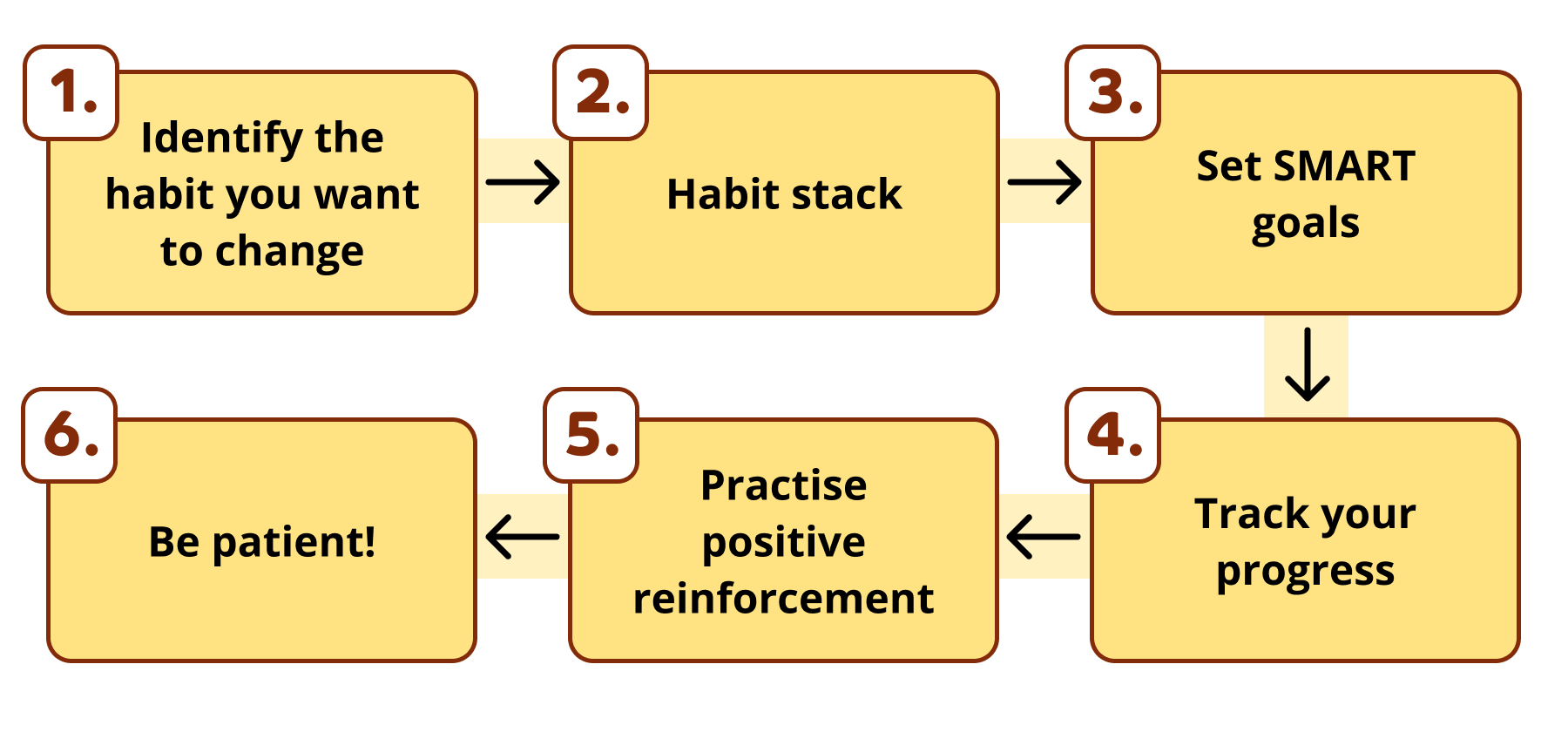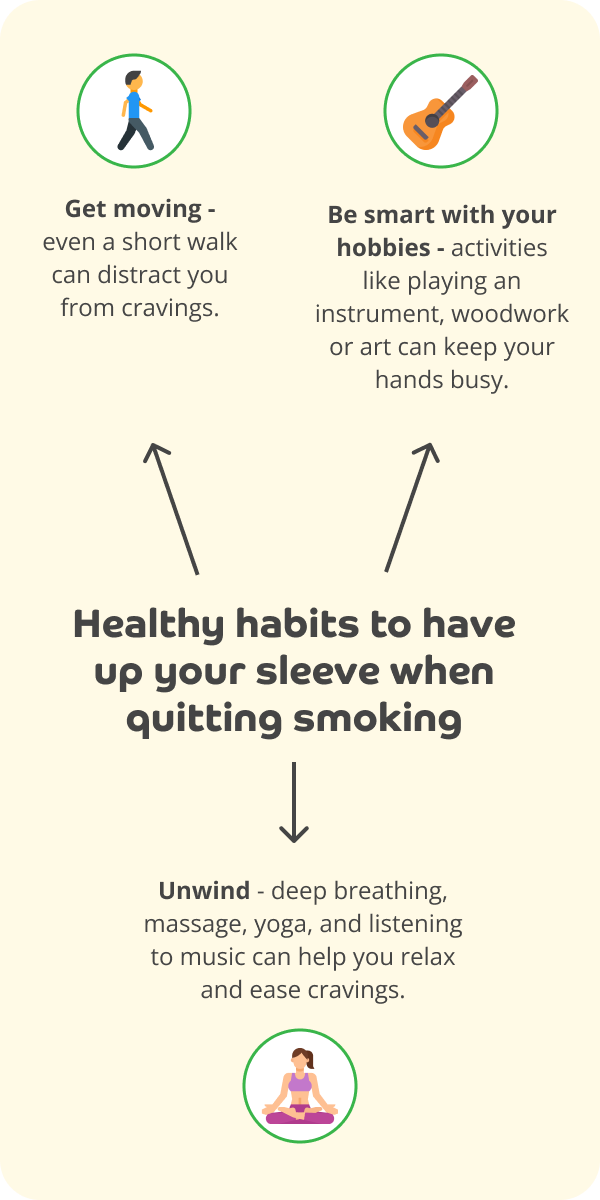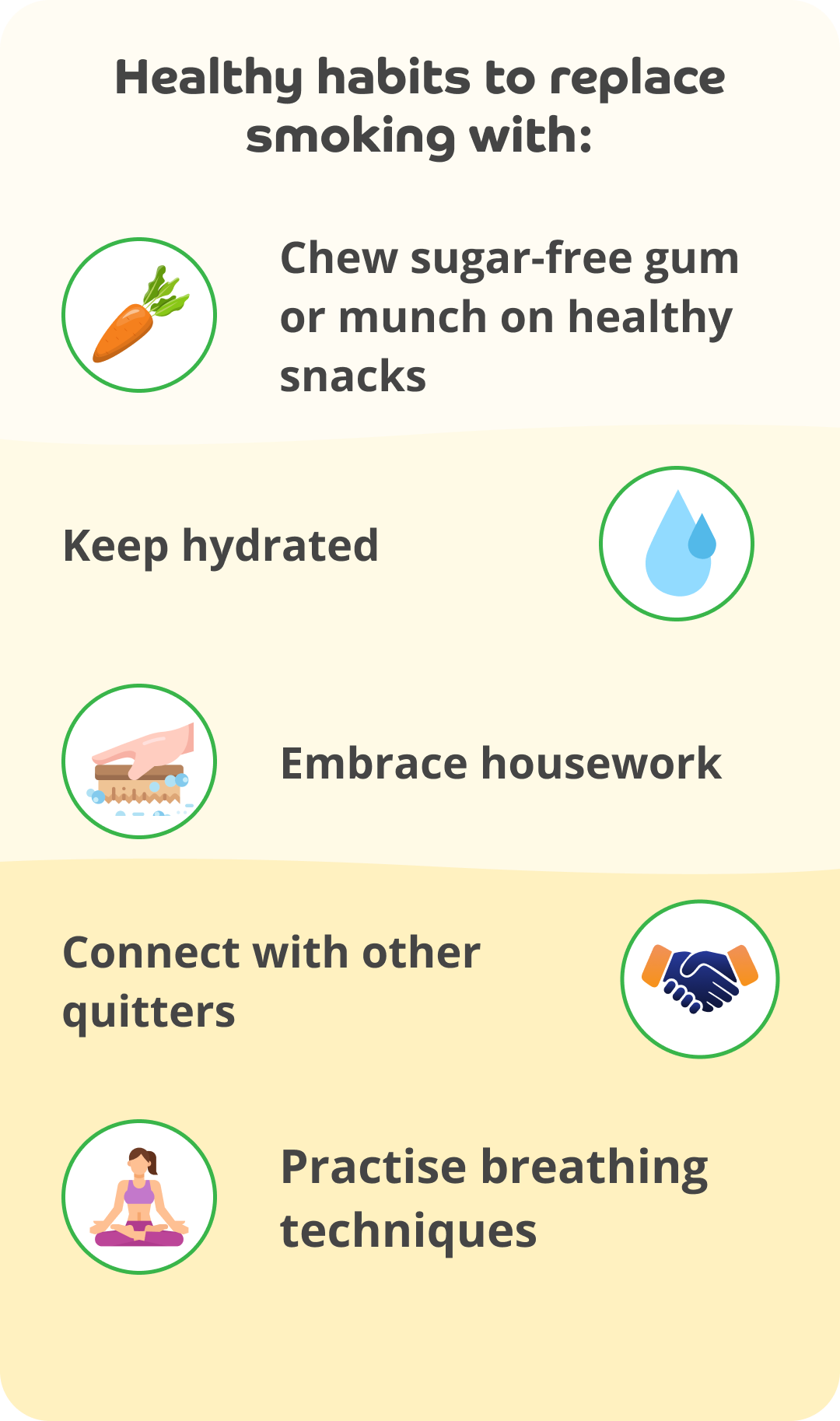It’s great that you’ve decided to work towards becoming smoke free! Successfully quitting smoking is an ongoing process, often made up of two elements:
- combating the physical addiction to the nicotine in cigarettes with tools like Nicotine Replacement Therapy and nicotine-free medicines, and
- overcoming the habits your mind associates with smoking.
If you’re a smoker or ex-smoker, in this article, I’ll help you focus on the latter, exploring effective behavioural strategies to help you enjoy the many benefits of becoming smoke free. If your loved one is a smoker, sharing these behaviour change ideas could help them, should they be embarking on a quit smoking journey.
How to make healthy habit changes stick when quitting smoking:
Before diving into healthy habits you can weave into your life to support you in becoming smoke free, it can help to understand the theory that underpins successful habit change:
- Begin by identifying the habit you want to change, in this case smoking, and break it down into realistic and less daunting steps. Rather than trying to shake up your whole lifestyle at once, start with small, achievable actions that will slowly create bigger, overall change. For instance, if you normally smoke during a coffee break, replace that routine with a quick walk or a chat with a colleague or loved one.
- Next, comes “habit stacking”, which helps you embed your new habit into your life. For example, if you enjoy reading or gaming in the evening, stack the new habit of practising deep breathing exercises (more on this below) for a few minutes right after you finish reading or gaming. This connection between something you enjoy and your new healthy habit can reinforce the new behaviour, make it seem more appealing, and act as a good reminder to do it.
- Setting SMART goals – Specific, Measurable, Achievable, Relevant, and Time-bound – can help you maintain motivation and focus on your stop smoking goal. You might set a goal to curb your cravings with the new coping strategy of exercise at least three times a week for one month. Tackling things in this way clarifies your target and provides you with a timeline to work towards.
Making quitting “manageable” is what semi-structured interviews with 15 IAPT (now known as The NHS Talking Therapies) service users revealed helped support their behaviour change. They described gaining “a couple of tricks up [their] sleeve” when they underwent an integrated cognitive behavioural technique-based intervention for quitting smoking and depression/anxiety (more on this below) that were helpful in making quitting feel more “manageable.”
What tricks will you keep up your sleeve for whenever quitting appears too overwhelming or daunting? - Tracking your progress is key when modifying habits. You can do this by using a habit tracker or calendar to visually mark off your smoke-free days and any coping strategies you’ve put in place. If saving money is one of your key reasons for quitting, you could record how much money you save each time you resist the urge to buy cigarettes. After all, rewards of money increased people’s chances of quitting for six months or longer in a review of 312 studies.
- As well as “habit stacking”, positive reinforcement can also help integrate new habits into your life. This is because rewarding yourself each time you practise your new healthy habit strengthens the neural pathways associated with it in your brain. If you manage to stay smoke free for a week, consider treating yourself to something you love – perhaps a nice meal or a small gift that recognises your efforts.
- Finally, be patient. Changing habits demands consistency and time, so try not to get deterred by setbacks. If you notice yourself reaching for a cigarette again, think about what prompted you to do so. Each time you resist smoking, you edge close to a smoke-free life, strengthening your commitment to long-term change.

How to deal with nicotine cravings: Have some distraction techniques up your sleeve
It can be reassuring and practical to have a plan for when cravings hit. This can include having a list of go-to distractions to help you overcome the urge to smoke. Ask yourself: what it is you enjoy doing? I’ve outlined some exam
- Get moving: Even short bursts of exercise, such as running up and down the stairs a few times, can banish nicotine cravings. Getting out for a short walk, bike ride or jog can distract you from them completely, so you don’t need to be a fitness fanatic to benefit from getting active.
- Unwind: Identifying ways to relax that work for you, like deep breathing, massage, yoga, listening to calming music, and muscle relaxation, can help ease cravings. These can be important activities to fall back on as struggling with cigarette cravings can be a stressful process.
- Be smart with your hobbies: Woodwork, knitting, playing an instrument, different types of art, are all hobbies that keep your hands busy – which can take your mind off your hands reaching for that next cigarette. Choosing activities that keep your hands occupied can be a great chance to learn something new or get re-acquainted with an old interest or passion.

More ways to overcome smoking addiction with behaviour change
- Chew sugar-free gum or munch on healthy snacks: As well as keeping your hands busy, it’s handy to keep your mouth occupied too, as doing so can help fulfil the mouth urges that often accompany nicotine cravings. Try swapping a cigarette with sugar-free gum, mints or healthy plant-based snacks, for example, carrot or celery sticks, or unsalted, unroasted nuts and seeds.
- Keep hydrated: Do you keep your fluids up? Making a point to regularly drink water or herbal teas throughout your day can help manage cravings. Our article on staying hydrated – and there’s more to it than drinking lots of water! – explains how maintaining hydration supports your overall health, which is especially important when you’re quitting smoking.
- Embrace housework: I know, most of us aren’t enthused by doing jobs around the house! However, as well as hobbies like reading and exercise I covered above, even simple tasks like cleaning or organising your cupboards can serve as a productive way to divert your attention from nicotine cravings.
- Connect with other quitters: Engaging with others who are trying to become smoke free can give you emotional support and practical advice. Perhaps someone in your life has tried a healthy habit that’s helped them stop smoking? Joining support groups, no matter if they’re informal and in-person, or online, can create a sense of community, helping to ensure you don’t feel alone.
- Practise breathing techniques: I mentioned above that deep breathing can support to some people relax, which can help deal with the stress that can be experienced when quitting smoking, but did you know deep breathing can also be a useful way to provide relief from cravings? Next time cravings hit, try taking a few slow, deep breaths. Doing so can help reduce feelings of anxiety linked to withdrawal.

A note about mental health and behaviour strategies
People with a lifetime history of depression are twice as likely to smoke compared to those who don’t live with depression. What’s more, smokers with depression experience more severe negative moods and are at increased risk of major depression after quitting. Effective strategies for quitting for people who fall into this category has included cognitive behavioural mood management (along with nicotine replacement therapy and others). If you think this applies to you, it might be worth speaking to your GP about investigating cognitive behavioural mood management support.
Even if you don’t live with depression, a large review of 312 studies found that there was strong evidence for the efficacy of providing counselling to help people quit for six months or longer. If you feel that you could benefit from counselling, whether to address the underlying reasons why you may smoke, or another reason, consider asking your GP to recommend some counselling services to you.
Becoming permanently smoke free requires perseverance, commitment and strategies that work for you. I hope the ideas shared above have given you some inspiration of what habits to try and replace smoking, with as well as a deeper understanding of how to implement behaviour change effectively. Which habit will you try first?
If you haven’t already, downloading the Evergreen Life app can help you understand more about your wellness and how to support it.
- Facebook (n.d.) Smokefree Quit Smoking Support Group. [online] Available here.
- Hartmann-Boyce J, Livingstone-Banks J, Ordóñez-Mena JM, et al. (2021) Behavioural interventions for smoking cessation: an overview and network meta‐analysis. Cochrane Database of Systematic Reviews. 1. Art. No.: CD013229. (doi: 10.1002/14651858.CD013229.pub2).
- Mayo Clinic (2025) Quitting Smoking: 10 Ways to resist tobacco cravings. [online] Available here.
- Mendelsohn C (2012) Smoking and depression – a review. Aust Fam Physican. 41(5):304-7 (PMID: 22558621).
- NHS England (n.d.) NHS Talking Therapies, for anxiety and depression. [online] Available here.
- Stein KF, Sawyer K, Daryan S, et al. (2023) Service-user experiences of an integrated psychological intervention for depression or anxiety and tobacco smoking in improving access to psychological therapies services: A qualitative investigation into mechanisms of change in quitting smoking. Health Expect. 26(1):498-509 (doi: 10.1111/hex.13684).





